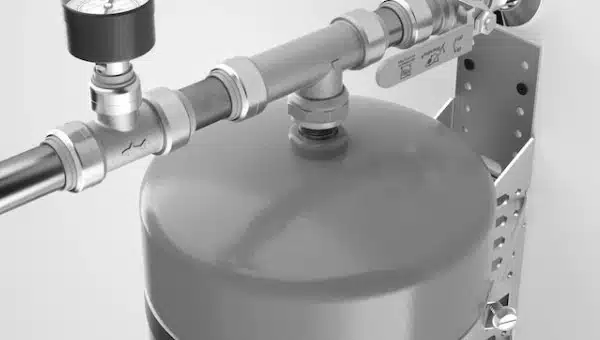When it comes to your home’s water heater, there are a few key components that play a crucial role in its efficient functioning. One such component is the expansion tank, which helps regulate the pressure and temperature within the water heater. However, installing an expansion tank can be a daunting task for many homeowners. To help you navigate through this process with ease, we have compiled a list of essential expansion tank tips. These tips will not only ensure a hassle-free experience but also extend the lifespan of your water heater. So, let’s dive into these tips and make sure your water heater is equipped with a reliable expansion tank.
Table of Contents
Understanding the Need for a Water Heater Expansion Tank
Unpacking the necessity of a water heater expansion tank might seem like a physics lesson you didn’t sign up for, but stick with us, it’s simpler than it sounds. Picture this: water being heated within your water heater is like a ballet dancer pirouetting in a small box – it needs room to maneuver. As water heats, it expands. The limited confines of your heater and plumbing system can’t always accommodate this increase in volume, causing a spike in pressure.
Now imagine this pressure without an appropriate release valve – it’s like a pot of boiling water with a lid clamped on tight. Eventually, it could bubble over, leading to leakage or worse, rupture in your plumbing system. This is where the water heater expansion tank comes into play. Think of it as the side-stage where the dancer can twirl without crashing into the walls. The expansion tank serves as a pressure release outlet, ensuring the heated water has space to expand without causing damage.
The inclusion of an expansion tank not only safeguards your plumbing system from unnecessary damage but also enhances the lifespan of your water heater. Now that’s what we call a win-win situation!
Choosing the Right Expansion Tank for Your Water Heater
Think of selecting the ideal expansion tank for your water heater as solving a puzzle – you need to find that perfect piece that seamlessly fits into your existing setup. The notion that all expansion tanks are created equal couldn’t be further from the truth. Your expansion tank should be in harmony with your water heater’s capacity and pressure, making it crucial to refer to your heater’s manufacturer specifications to determine the suitable tank size.
But that’s not all. Remember to ensure your selected expansion tank is designed for potable water usage. The significance of this detail might escape your attention but trust us, you don’t want an expansion tank that’s not made to handle drinkable water.
Also, it’s worth noting that the expansion tank should pass the muster of local building and plumbing codes. This detail is crucial not just for compliance but also for ensuring the safety and efficiency of your setup. While we all love a good DIY project, we certainly don’t want to compromise the functionality of a critical household system, do we?
So there you have it. Selecting the right expansion tank is about more than just ‘plug and play’. It’s about doing your homework, understanding your specific requirements, and making an informed choice. The reward? A seamlessly functioning water heater system that delivers exactly what you need, when you need it!

Proper Location for Installation
Finding the perfect spot for your expansion tank isn’t a game of hide-and-seek. The location plays a pivotal role in its operation and efficiency. The rule of thumb is to position the expansion tank on the cold-water line in proximity to your water heater. But remember, it’s not about playing hot and cold with your expansion tank. Avoid spots prone to freezing temperatures as this can affect your tank’s performance.
The orientation of the expansion tank is also of prime importance. Consider installing it vertically. Not only does this position resemble a standing ovation for the excellent job your tank is doing, but it also lessens the stress on both the tank and the water line. It’s like putting less pressure on a diligent student – they tend to perform better!
Let’s not forget about accessibility either. Just like your favorite jar of cookies should be within easy reach, so should your expansion tank. You’ll need to have access to it for those essential maintenance checks and routine inspections. So choose a location that’s convenient for you to reach without turning into a contortionist.
So, think of your expansion tank as a Goldilocks. It doesn’t want to be too high, too low, too hot, or too cold. It just wants to be in the spot that’s just right. Remember, the perfect location can greatly enhance the longevity and functionality of your expansion tank. So take your time, consider your options, and choose wisely!
The Installation Process
Ready for the final act? It’s showtime! The star of the show, your expansion tank, is all set to take center stage right next to your water heater. But hold on a second! Let’s not rush into it without ensuring safety first. Before you begin, make sure you turn off your water heater and water supply. Safety first, always!
Now, onto the nitty-gritty of the installation process. Start by incorporating the expansion tank into your plumbing family using a tee fitting. Think of this fitting as the bridge that unites your water line and expansion tank. Ensure you tighten each connection securely. We wouldn’t want any loose ends, would we?
Remember, this is a task that requires precision and accuracy. A leaky or improperly installed expansion tank is like a ticking time bomb – it can lead to unnecessary damage and costs down the line. If you have any doubts about your DIY skills, it’s always a smart move to bring in a professional. Just like you’d call a doctor for a medical condition, call a licensed plumber for plumbing issues. It’s their field of expertise, and they can guarantee a job well done.
So, there you have it. You’re all set to install your water heater expansion tank. However, remember that the job isn’t complete once the tank is installed. The journey continues with post-installation checks and routine maintenance to ensure your system continues to perform at its peak. So, get ready to roll up your sleeves and embrace the adventure that is installing a water heater expansion tank. Good luck!
Post-installation Checks and Maintenance
So, you’ve successfully installed your water heater expansion tank – kudos to you! But hold on, don’t dust off those hands just yet. The journey of an expansion tank doesn’t end with installation. Think of your expansion tank as a trusty companion – it’s there for you, but it also needs your attention in return.
You wouldn’t install a smoke alarm and then forget to check if it’s functioning correctly, right? The same goes for your expansion tank. Once installed, it’s vital to conduct a thorough check for leaks and confirm that the tank’s pressure aligns with the water supply line pressure. It’s like taking a car for a test drive after a tune-up – you need to ensure that all parts are working together harmoniously.
Remember, this is not a one-and-done deal. Just as you would regularly change the oil in your car or get a dental check-up, your expansion tank also needs routine maintenance. A good rule of thumb is to check the tank’s pressure at least once a year or if you notice any noticeable drop in your water pressure.
Also, keep an eye out for water coming out of the pressure relief valve on your water heater. If you see this, consider it as your expansion tank waving a red flag at you. It’s their way of saying, “Something’s not right here!”. This could be a signal that the expansion tank isn’t functioning as it should, and it’s time to get it checked out.
Maintaining your expansion tank might seem like an additional task on your already lengthy to-do list, but it’s a small price to pay for the peace of mind you’ll get in return. Knowing that your expansion tank is in top shape means one less thing to worry about. So keep those sleeves rolled up, and remember – a little care goes a long way in ensuring the longevity and functionality of your water heater expansion tank. Happy maintaining!
FAQ’s About Expansion Tank Tips
Is it normal for expansion tanks to be filled with water?
By volume, the expansion tank is normally half full of water and half full of air. When pressured, one tank of air at atmospheric pressure will be about half its capacity. Drain it when in doubt. To begin, close the valve between the tank and the boiler, as well as the remainder of the system.
How should an expansion tank be installed?
A tee-fitting inserted in the cold water supply line is typically used to install an expansion tank right above the water heater. The expansion tank is typically erected vertically, though it is okay to position it horizontally if space is limited.
How many PSI should an expansion tank have?
Expansion tanks are pre-charged to approximately 40 PSI, however the pressure must be adjusted dependent on the water pressure in the home. If the pressure inside the tank is too high or too low, the tank may fail.
How far away from the water heater may the expansion tank be?
An expansion tank, such as the one pictured above, aids in the absorption of water pressure caused by thermal expansion. The tank can be positioned anywhere in the cold-water line between the house’s main valve and the water heater, or within 3 to 5 feet of the water heater on the hot-water line.
Conclusion
Clovis Plumbing is a family-owned business that is known for providing affordable, high-quality plumbing services. Any plumbing need can be met by our team thanks to our extensive experience and personalized service. It is recommended that you contact Clovis Plumbing if you require plumbing services for any kind of project, regardless of how big or how minor it may be.
